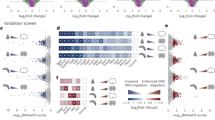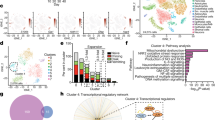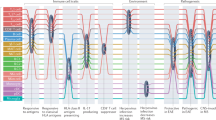Abstract
Microarray analysis of multiple sclerosis (MS) lesions obtained at autopsy revealed increased transcripts of genes encoding inflammatory cytokines, particularly interleukin-6 and -17, interferon-γ and associated downstream pathways. Comparison of two poles of MS pathology—acute lesions with inflammation versus 'silent' lesions without inflammation—revealed differentially transcribed genes. Some products of these genes were chosen as targets for therapy of experimental autoimmune encephalomyelitis (EAE) in mice. Granulocyte colony-stimulating factor is upregulated in acute, but not in chronic, MS lesions, and the effect on ameliorating EAE is more pronounced in the acute phase, in contrast to knocking out the immunoglobulin Fc receptor common γ chain where the effect is greatest on chronic disease. These results in EAE corroborate the microarray studies on MS lesions. Large-scale analysis of transcripts in MS lesions elucidates new aspects of pathology and opens possibilities for therapy.
This is a preview of subscription content, access via your institution
Access options
Subscribe to this journal
Receive 12 print issues and online access
$209.00 per year
only $17.42 per issue
Buy this article
- Purchase on Springer Link
- Instant access to full article PDF
Prices may be subject to local taxes which are calculated during checkout





Similar content being viewed by others
References
Raine, C.S. The neuropathology of multiple sclerosis. in Multiple Sclerosis: Clinical and Pathogenetic Basis (eds. Raine, C.S., McFarland, H.F. & Tourtelotte, W.W) 151–171 (Chapman and Hall, London, 1997).
Eisen, M.B., Spellman, P.T., Brown, P.O. & Botstein, D. Cluster analysis and display of genome-wide expression patterns. Proc. Natl. Acad. Sci. USA 95, 14863–14868 (1998).
Waring, J.F. et al. Clustering of hepatotoxins based on mechanism of toxicity using gene expression profiles. Toxicol. Appl. Pharmacol. 175, 28–42 (2001).
Schadt, E.E., Li, C., Su, C. & Wong, W.H. Analyzing high-density oligonucleotide gene expression array data. J. Cell Biochem. 80, 192–202 (2000).
Schadt, E.E., Li, C., Ellis, B. & Wong, W.H. Feature extraction and normalization algorithms for high-density oligonucleotide gene expression array data. J. Cell Biochem. Suppl., 120–125 (2001).
Hong, J.X., Wilson, G.L., Fox, C.H. & Kehrl, J.H. Isolation and characterization of a novel B cell activation gene. J. Immunol. 150, 3895–3904 (1993).
Dabiri, G.A., Young, C.L., Rosenbloom, J. & Southwick, F.S. Molecular cloning of human macrophage capping protein cDNA. A unique member of the gelsolin/villin family expressed primarily in macrophages. J. Biol. Chem 267, 16545–16552 (1992).
Kozopas, K.M., Yang, T., Buchan, H.L., Zhou, P. & Craig, R.W. MCL1, a gene expressed in programmed myeloid cell differentiation, has sequence similarity to BCL2. Proc. Natl. Acad. Sci. USA 90, 3516–3520 (1993).
Rehli, M., Krause, S.W. & Andreesen, R. Molecular characterization of the gene for human cartilage gp-39 (CHI3L1), a member of the chitinase protein family and marker for late stages of macrophage differentiation. Genomics 43, 221–225 (1997).
Davoust, N. et al. Central nervous system-targeted expression of the complement inhibitor sCrry prevents experimental allergic encephalomyelitis. J. Immunol. 163, 6551–6556 (1999).
Walsh, L.A., Tone, M., Thiru, S. & Waldmann, H. The CD59 antigen—a multifunctional molecule. Tissue Antigens 40, 213–220 (1992).
Hauser, S.L., Doolittle, T.H., Lincoln, R., Brown, R.H. & Dinarello, C.A. Cytokine accumulations in CSF of multiple sclerosis patients: Frequent detection of interleukin-1 and tumor necrosis factor but not interleukin-6. Neurology 40, 1735–1739 (1990).
Jacobs, C.A. et al. Experimental autoimmune encephalomyelitis is exacerbated by IL-1 α and suppressed by soluble IL-1 receptor. J. Immunol. 146, 2983–2989 (1991).
Matusevicius, D. et al. Interleukin-17 mRNA expression in blood and CSF mononuclear cells is augmented in multiple sclerosis. Mult. Scler. 5, 101–104 (1999).
Raine, C.S., Bonetti, B. & Cannella, B. Multiple sclerosis: Expression of molecules of the tumor necrosis factor ligand and receptor families in relationship to the demyelinated plaque. Rev. Neurol. (Paris) 154, 577–585 (1998).
Akira, S. & Kishimoto, T. IL-6 and NF-IL6 in acute-phase response and viral infection. Immunol. Rev. 127, 25–50 (1992).
Gijbels, K., Brocke, S., Abrams, J.S. & Steinman, L. Administration of neutralizing antibodies to interleukin-6 (IL-6) reduces experimental autoimmune encephalomyelitis and is associated with elevated levels of IL-6 bioactivity in central nervous system and circulation. Mol. Med. 1, 795–805 (1995).
Akassoglou, K., Probert, L., Kontogeorgos, G. & Kollias, G. Astrocyte-specific but not neuron-specific transmembrane TNF triggers inflammation and degeneration in the central nervous system of transgenic mice. J. Immunol. 158, 438–445 (1997).
Mao, Z., Bonni, A., Xia, F., Nadal-Vicens, M. & Greenberg, M.E. Neuronal activity-dependent cell survival mediated by transcription factor MEF2. Science 286, 785–790 (1999).
Penkowa, M. et al. Altered inflammatory response and increased neurodegeneration in metallothionein I+II deficient mice during experimental autoimmune encephalomyelitis. J. Neuroimmunol. 119, 248–260 (2001).
Pitt, D., Werner, P. & Raine, C.S. Glutamate excitotoxicity in a model of multiple sclerosis. Nature Med. 6, 67–70 (2000).
Trapp, B.D. et al. Axonal transection in the lesions of multiple sclerosis. N. Engl. J. Med. 338, 278–285 (1998).
Yan, Y., Lagenaur, C. & Narayanan, V. Molecular cloning of M6: Identification of a PLP/DM20 gene family. Neuron 11, 423–431 (1993).
Yednock, T.A. et al. Prevention of experimental autoimmune encephalomyelitis by antibodies against α4β1 integrin. Nature 356, 63–66 (1992).
Steinman, L. Assessment of the utility of animal models for MS and demyelinating disease in the design of rational therapy. Neuron 24, 511–514 (1999).
Takai, T., Li, M., Sylvestre, D., Clynes, R. & Ravetch, J.V. FcRγ chain deletion results in pleiotrophic effector cell defects. Cell 76, 519–529 (1994).
Miyajima, I. et al. Systemic anaphylaxis in the mouse can be mediated largely through IgG1 and FcγRIII. Assessment of the cardiopulmonary changes, mast cell degranulation, and death associated with active or IgE- or IgG1- dependent passive anaphylaxis. J. Clin. Invest. 99, 901–914 (1997).
Samuelsson, A., Towers, T.L. & Ravetch, J.V. Anti-inflammatory activity of IVIG mediated through the inhibitory Fc receptor. Science 291, 484–486 (2001).
Achiron, A. et al. Intravenous immunoglobulin treatment of experimental T cell-mediated autoimmune disease. Upregulation of T-cell proliferation and downregulation of tumor necrosis factor α secretion. J. Clin. Invest. 93, 600–605 (1994).
Wucherpfennig, K.W. et al. Recognition of the immunodominant myelin basic protein peptide by autoantibodies and HLA-DR2-restricted T-cell clones from multiple sclerosis patients. Identity of key contact residues in the B-cell and T-cell epitopes. J. Clin. Invest. 100, 1114–1122 (1997).
Warren, K.G., Catz, I. & Steinman, L. Fine specificity of the antibody response to myelin basic protein in the central nervous system in multiple sclerosis: The minimal B-cell epitope and a model of its features. Proc. Natl. Acad. Sci. USA 92, 11061–11065 (1995).
Genain, C.P., Cannella, B., Hauser, S.L. & Raine, C.S. Identification of autoantibodies associated with myelin damage in multiple sclerosis. Nature Med. 5, 170–175 (1999).
Whitney, L.W. et al. Analysis of gene expression in mutiple sclerosis lesions using cDNA microarrays. Ann. Neurol. 46, 425–428 (1999).
Wraith, D.C., Smilek, D.E., Mitchell, D.J., Steinman, L. & McDevitt, H.O. Antigen recognition in autoimmune encephalomyelitis and the potential for peptide-mediated immunotherapy. Cell 59, 247–255 (1989).
Pedotti, R. et al. An unexpected version of horror autotoxicus: Anaphylactic shock to a self-peptide. Nature Immunol. 2, 216–222 (2001).
Lucchinetti, C. et al. Heterogeneity of multiple sclerosis lesions: Implications for the pathogenesis of demyelination. Ann. Neurol. 47, 707–717 (2000).
Haines, J.L. et al. A complete genomic screen for multiple sclerosis underscores a role for the major histocompatability complex. The Multiple Sclerosis Genetics Group. Nature Genet 13, 469–471 (1996).
Ebers, G.C. et al. A full genome search in multiple sclerosis. Nature Genet. 13, 472–476 (1996).
Sawcer, S. et al. A genome screen in multiple sclerosis reveals susceptibility loci on chromosome 6p21 and 17q22. Nature Genet. 13, 464–468 (1996).
Zavala, F. et al. G-CSF therapy of ongoing experimental allergic encephalomyelitis via chemokine- and cytokine-based immune deviation. J. Immunol. 168, 2011–2019 (2002).
Matarese, G. et al. Requirement for leptin in the induction and progression of autoimmune encephalomyelitis. J. Immunol. 166, 5909–16 (2001).
Mountjoy, K.G., Robbins, L.S., Mortrud, M.T. & Cone, R.D. The cloning of a family of genes that encode the melanocortin receptors. Science 257, 1248–1251 (1992).
Poliak, S. et al. Stress and autoimmunity: The neuropeptides corticotropin-releasing factor and urocortin suppress encephalomyelitis via effects on both the hypothalamic-pituitary-adrenal axis and the immune system. J. Immunol. 158, 5751–5756 (1997).
Acknowledgements
We thank J. Woody, R. Booth and H. Van Wart for support during the course of this work; H. Gmuender for help optimizing use of the technology; S. Wilson for developing methods to handle and isolate RNA from human samples; F. Zuo for helpful comments on the manuscript; J. Kumm for advice on bioinformatics; M.C. Jeong for technical help; and Roche Bioscience for support and access to gene-chip technology. This study was supported in part by post-doctoral fellowships from the National Multiple Sclerosis Society to C.L., G.H. and R.P. J.O. is supported by grants from the NIH (NIHAI35761) and the National Multiple Sclerosis Society (RG2901). C.S.R. is supported by NIH grants NS08952 and NS11920. L.S. is supported by NIH grants NIH18235, 30201, 41402 and 28579.
Author information
Authors and Affiliations
Corresponding authors
Ethics declarations
Competing interests
L.S. is on the Scientific Advisory Board of Roche Biosciences. R.H., J.A., P.K., N.L. and A.A. were employees at Roche Biosciences during these studies.
Supplementary information
Rights and permissions
About this article
Cite this article
Lock, C., Hermans, G., Pedotti, R. et al. Gene-microarray analysis of multiple sclerosis lesions yields new targets validated in autoimmune encephalomyelitis. Nat Med 8, 500–508 (2002). https://doi.org/10.1038/nm0502-500
Received:
Accepted:
Issue Date:
DOI: https://doi.org/10.1038/nm0502-500
This article is cited by
-
The brain cytokine orchestra in multiple sclerosis: from neuroinflammation to synaptopathology
Molecular Brain (2024)
-
Protective role of IL-17-producing γδ T cells in a laser-induced choroidal neovascularization mouse model
Journal of Neuroinflammation (2023)
-
The role of systemic ımmune ınflammatory ındex in showing active lesion ın patients with multiple sclerosis
BMC Neurology (2023)
-
Characterizing the neuroimmune environment of offspring in a novel model of maternal allergic asthma and particulate matter exposure
Journal of Neuroinflammation (2023)
-
Pro- and anti-inflammatory bioactive lipids imbalance contributes to the pathobiology of autoimmune diseases
European Journal of Clinical Nutrition (2023)



